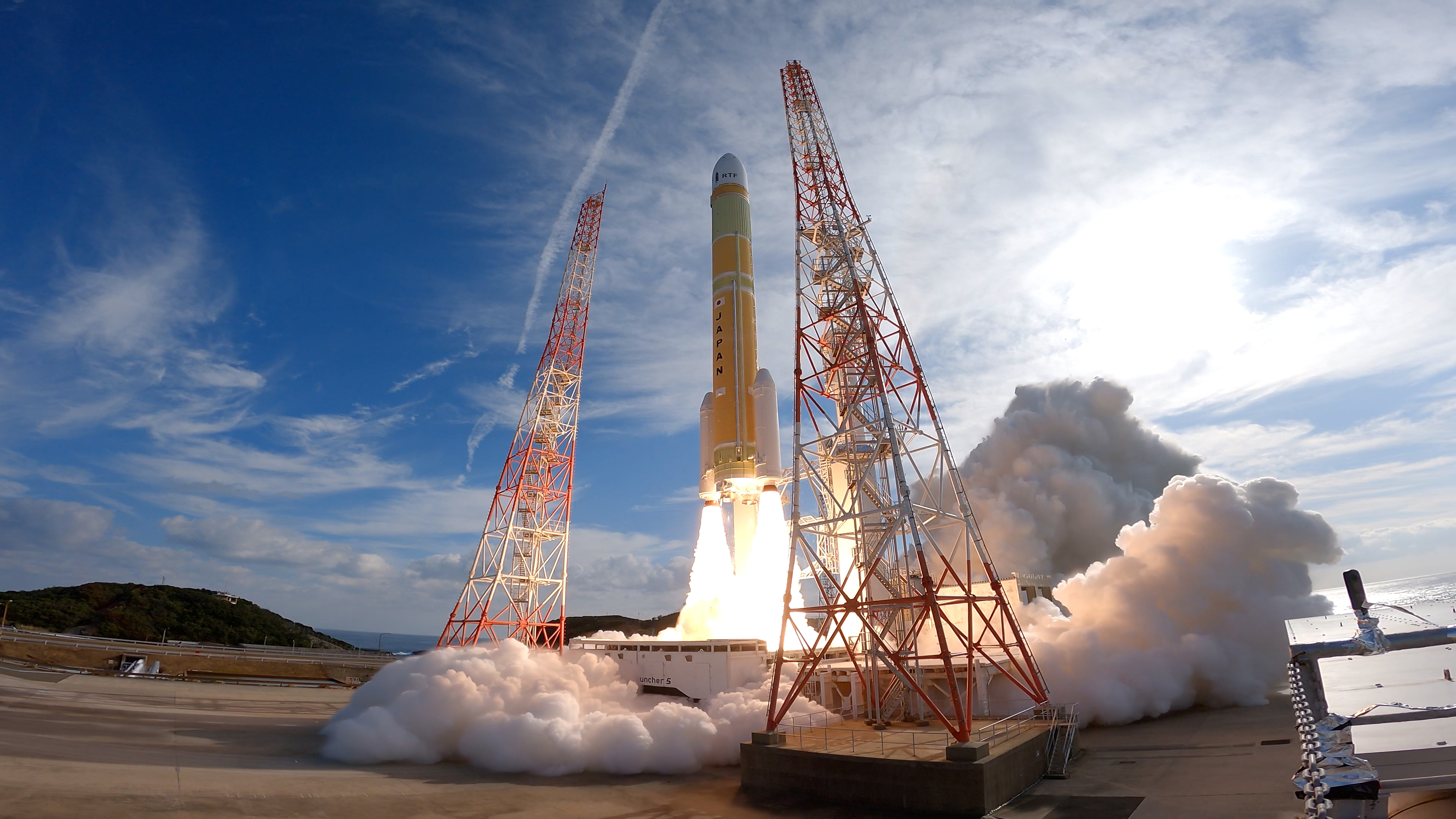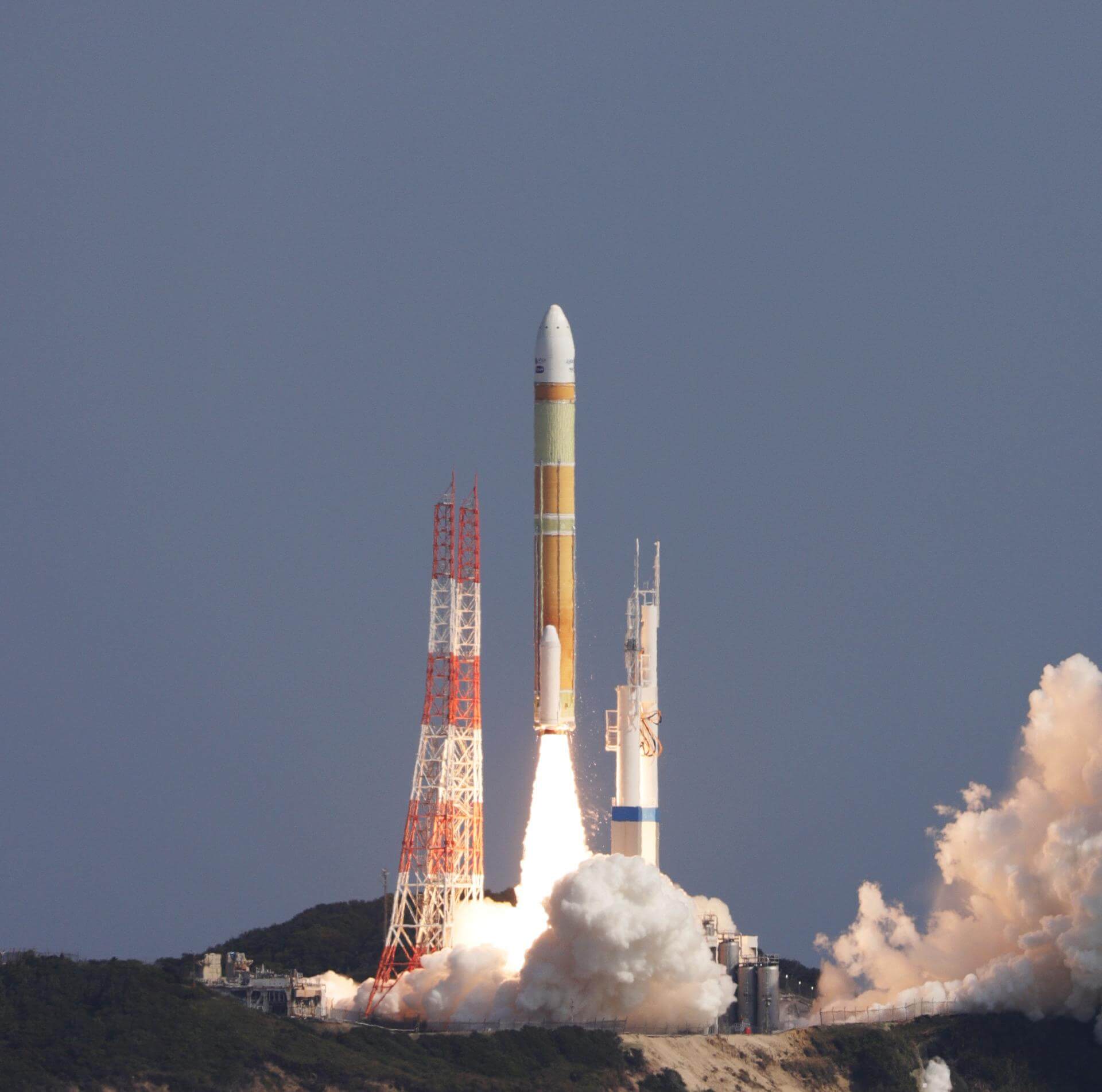
H3-22
ActiveMitsubishi Heavy Industries (MHI)
March 7, 2023
Description
The H3 Launch Vehicle is a Japanese expendable launch system. Each H3 booster configuration has a two-digit and a letter designation that indicates the features of that configuration. The first digit represents the number of LE-9 engines on the main stage, either "2" or "3". The second digit indicates the number of SRB-3 solid rocket boosters attached to the base of the rocket, and can be "0", "2" or "4". All layouts of solid boosters are symmetrical. The letter in the end shows the length of the payload fairing, either short "S" or long "L". For example, an H3-24L has two engines, four solid rocket boosters, and a long fairing, whereas an H3-30S has three engines, no solid rocket boosters, and a short fairing.
Specifications
-
Stages
2 -
Length
63.0 m -
Diameter
5.27 m -
Fairing Diameter
5.27 m -
Launch Mass
― -
Thrust
7542.0 kN
Family
-
Name
H3-22 -
Family
― -
Variant
22 -
Alias
― -
Full Name
H3-22
Payload Capacity
-
Launch Cost
$50000000 -
Low Earth Orbit
― -
Geostationary Transfer
Orbit
5400.0 kg -
Direct Geostationary
― -
Sun-Synchronous Capacity
―
Mitsubishi Heavy Industries
Commercial
President: Seiji Izumisawa
MHI 1884Mitsubishi Heavy Industries, Ltd. is a Japanese multinational engineering, electrical equipment and electronics company headquartered in Tokyo, Japan. MHI is one of the core companies of the Mitsubishi Group. MHI's products include aerospace components, air conditioners, aircraft, automotive components, forklift trucks, hydraulic equipment, machine tools, missiles, power generation equipment, printing machines, ships and space launch vehicles. Through its defense-related activities, it is the world's 23rd-largest defense contractor measured by 2011 defense revenues and the largest based in Japan.
Upcoming Spaceflights
H3-22 | Michibiki 7 (QZS-7)
Mitsubishi Heavy Industries | JapanTanegashima Space Center, Japan
Feb. 1, 2026, 7:30 a.m.
Status: Go for Launch
Mission:
QZSS (Quasi Zenith Satellite System) is a Japanese satellite navigation system operating from inclined, elliptical geosynchronous orbits to achieve optimal high-elevation visibility in urban canyons and mountainous areas. The navigation system objective is to broadcast GPS-interoperable and augmentation signals as well as original Japanese (QZSS) signals from a three-spacecraft constellation. The navigation system objective is to broadcast GPS-interoperable and augmentation signals as well as original Japanese (QZSS) signals from a three-spacecraft constellation in inclined, elliptical geosynchronous orbits.
Geostationary Transfer OrbitH3-22 | ETS-9
Mitsubishi Heavy Industries | JapanTanegashima Space Center, Japan
TBD December, 2026
Status: To Be Determined
Mission:
The Engineering Test Satellite 9 (ETS-9) is a JAXA project aimed to develop an advanced satellite bus, or common model, for various high-throughput satellites (HTS) for communications. The new satellite bus by Mitsubishi Electric will focus specifically on advanced communication needs: - Up to 25kW of power to support HTS communications - Light mass, all-electric bus system achieved with 6kW high-power Hall thrusters (Japan-made). - High-power Hall thrusters significantly shorten delivery of orbiting satellite compared to other manufacturer’s 4.5kW-class electric-propulsion bus systems - The first Japanese geostationary satellite equipped with GPS receivers (Japan-made) for laborsaving autonomous orbital transfer and orbital maneuvering.
Geostationary Transfer OrbitH3-22 | Michibiki 5 (QZS-5)
Mitsubishi Heavy Industries | JapanTanegashima Space Center, Japan
Dec. 22, 2025, 1:51 a.m.
Status: Launch Failure
Mission:
QZSS (Quasi Zenith Satellite System) is a Japanese satellite navigation system operating from inclined, elliptical geosynchronous orbits to achieve optimal high-elevation visibility in urban canyons and mountainous areas. The navigation system objective is to broadcast GPS-interoperable and augmentation signals as well as original Japanese (QZSS) signals from a three-spacecraft constellation. The navigation system objective is to broadcast GPS-interoperable and augmentation signals as well as original Japanese (QZSS) signals from a three-spacecraft constellation in inclined, elliptical geosynchronous orbits.
Geosynchronous Transfer OrbitH3-22 | Michibiki 6 (QZS-6)
Mitsubishi Heavy Industries | JapanTanegashima Space Center, Japan
Feb. 2, 2025, 8:30 a.m.
Status: Launch Successful
Mission:
QZSS (Quasi Zenith Satellite System) is a Japanese satellite navigation system operating from inclined, elliptical geosynchronous orbits to achieve optimal high-elevation visibility in urban canyons and mountainous areas. The navigation system objective is to broadcast GPS-interoperable and augmentation signals as well as original Japanese (QZSS) signals from a three-spacecraft constellation. The navigation system objective is to broadcast GPS-interoperable and augmentation signals as well as original Japanese (QZSS) signals from a three-spacecraft constellation in inclined, elliptical geosynchronous orbits.
Geostationary Transfer OrbitH3-22 | DSN 3 (Kirameki 3)
Mitsubishi Heavy Industries | JapanTanegashima Space Center, Japan
Nov. 4, 2024, 6:48 a.m.
H3-22 | Advanced Land Observing Satellite-4 (ALOS-4)
Mitsubishi Heavy Industries | JapanTanegashima Space Center, Japan
July 1, 2024, 3:06 a.m.
H3-22 | VEP 4, CE-SAT-1E & TIRSAT
Mitsubishi Heavy Industries | JapanTanegashima Space Center, Japan
Feb. 17, 2024, 12:22 a.m.
Status: Launch Successful
Mission:
New test flight of the H3 ordered following the failure of the inaugural launch of H3 in March 2023 with ALOS-3. Main payload is VEP 4 (Vehicle Evaluation Payload 4), a 2.6 tonnes mass simulator payload that will be carried on the 2nd test flight of the H3 rocket, instead of the ALOS-4 Earth observation satellite as originally planned. It will be deployed after the 2nd de-orbit burn is completed to test the payload separation mechanism. 2 hitchhiking secondary payloads have been selected in June 2023: * CE-SAT-1E - 70 kilograms class optical Earth observation satellite from Canon Electronics Inc., similar to the previously launched CE-SAT-1. * TIRSAT - 3U cubesat by Japan Space Systems and other institutes to test an infrared sensor for Earth surface observation purposes.
Sun-Synchronous OrbitH3-22 | ALOS-3 (Maiden flight)
Mitsubishi Heavy Industries | JapanTanegashima Space Center, Japan
March 7, 2023, 1:37 a.m.
Status: Launch Failure
Mission:
Maiden flight of the H3 launch vehicle, carrying the Advanced Land Observing Satellite-3 (ALOS-3). ALOS-3, also known as Advanced Optical Satellite is a successor of the optical mission of the Advanced Land Observation Satellite “DAICHI” (ALOS). The new satellite will achieve improved ground resolution (0.8 m) while observing a wide -swath (70 km) by a larger sensor with higher performance compared to DAICH, and continuously observe not only Japan but also global land areas to construct a system that can swiftly and timely acquire, process and distribute image data. Based on the accumulated data captured in pre- and post-disaster times, the satellite aims to become one of the imperative devices for disaster prevention and preparation activities of countries and municipal governments. Observation data acquired by the satellite is also expected to be useful in various fields such as contributing to the maintenance and updates of precise geospatial information in Japan as well as developing countries, and research and applications on coastal and land environmental monitoring by its observation capabilities.
Sun-Synchronous OrbitLong March 3B/E
Fengyun-4C
Launch Complex 2 (LC-2) - Xichang Satellite Launch Center, People's Republic of ChinaChina's geostationary meteorological satellite program FY-4 (Feng Yun 4) is the second generation of chinese geostationary meteorological satellites.
Long March 8A
SatNet LEO Group 17
Commercial LC-1 - Wenchang Space Launch Site, People's Republic of ChinaA batch of 9 Low Earth Orbit communication satellites for the Chinese state owned SatNet constellation operated by the China Satellite Network Group.…
Soyuz 2.1a
Obzor-R No.1
43/4 (43R) - Plesetsk Cosmodrome, Russian FederationNote: Assignment of payloads to this launch is uncertain. The Russian Obzor-R satellite is a planned X-band radar earth observation satellite desi…
LVM-3 (GSLV Mk III)
BlueBird Block 2 #1
Satish Dhawan Space Centre Second Launch Pad - Satish Dhawan Space Centre, IndiaAST SpaceMobile’s Block 2 BlueBird satellites are designed to deliver up to 10 times the bandwidth capacity of the BlueBird Block 1 satellites, requi…
Long March 12A
Demo Flight
Long March 12A Pad - Jiuquan Satellite Launch Center, People's Republic of ChinaFirst test launch of CASC/SAST’s Long March 12A rocket, with a dummy payload. The rocket’s 1st stage attempted to land on a landing pad about 300 km …


